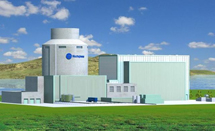Rethinking Nuclear Power
 It’s not your grandfather’s nuclear power plant anymore. Today it’s safer, cleaner and with an unlimited supply, the only “green” alternative able to ween us from our addiction to oil, gas and coal. Of course politics, crony-capitalism and fear-mongering currently prevent it from happening in the US.
It’s not your grandfather’s nuclear power plant anymore. Today it’s safer, cleaner and with an unlimited supply, the only “green” alternative able to ween us from our addiction to oil, gas and coal. Of course politics, crony-capitalism and fear-mongering currently prevent it from happening in the US.As of March 2011, China is building 27 new nuclear power plants (and plans 50). Russia is building 10, India and South Korea five each, Japan and Canada two. In the US, there is exactly one new reactor complex being built.
France gets 80% of its power from fission. Most major nations have used nuclear power to make their environment cleaner and their economies less vulnerable to $100/barrel oil. Yet the US remains in superstitious dread of fission… even while dependent on the 20% of our electricity that comes from our 40-year-old Homer Simpson specials.
The first hard fact about switching to nuclear power: it reduces your radiation exposure. Nuclear power plants, even old ones, release very little radiation. In fact, they release from 100 to 400 times less than coal plants, per kilowatt-hour. (There is a significant amount of radium and polonium in coal). You get more radiation by escaping to NH from Vermont than you would by living next to a reactor for your whole life (manly NH granite is full of uranium and thorium, unlike the soft, limp sediments of Vermont).
New nuclear plants are also meltdown free. There are several ways to make nuclear fuel rods or pellets that stop fissioning when they reach a certain temperature. The US built the first intrinsically safe reactor in 1986, the Argonne EBR-II. The Argonne system used fuel rods made of an alloy that expanded with heat to beyond critical density. Newer designs have used pebble beds and Doppler scattering, but the result is the same: fuel elements that shut off over a certain temperature, even if Homer Simpson turns off every cooling system.
Yet another breed of new nuclear plants uses cooling systems which use convection instead of pumps; again, even if everything is switched off, they can’t overheat. The Westinghouse AP1000 uses this principle. (The Westinghouse nuclear division is now owned by Toshiba, a company that thinks more than one fiscal quarter ahead.)
Other concepts include small mass-produced reactors like the Hyperion. These town-sized (only 25 megawatt) units would be more decentralized than most current fossil or nuclear generators. They would also have passive safety features… in fact the reactor itself is a sealed unit, with no way for Homer to get inside.
The US has none of the newer, safer plants yet (the one reactor under construction in Georgia is an AP1000). Yet just like the ex-Soviet satellite nations, we remain economically dependent on our 1970s reactors. Again, our anti-nuclear policy has put us at more risk than other nations.
Currently known reserves of uranium are enough for a couple hundred years or so… enough that no one puts much effort into finding more. Breeder reactors can make more uranium out of thorium; estimates of thorium reserves get us up to 20,000 years. By the year 22,211, fission reactors will be in museums next to the flint-knapping tools. The lights will stay on from fusion… or more likely, something we haven’t even imagined.
Even on a shorter time scale, nuclear fuel cycles are very stable. Once fueled, a reactor will run for years, independent of possible wars, blockades or interruptions of trade.
You can return to the main Market News page, or press the Back button on your browser.

